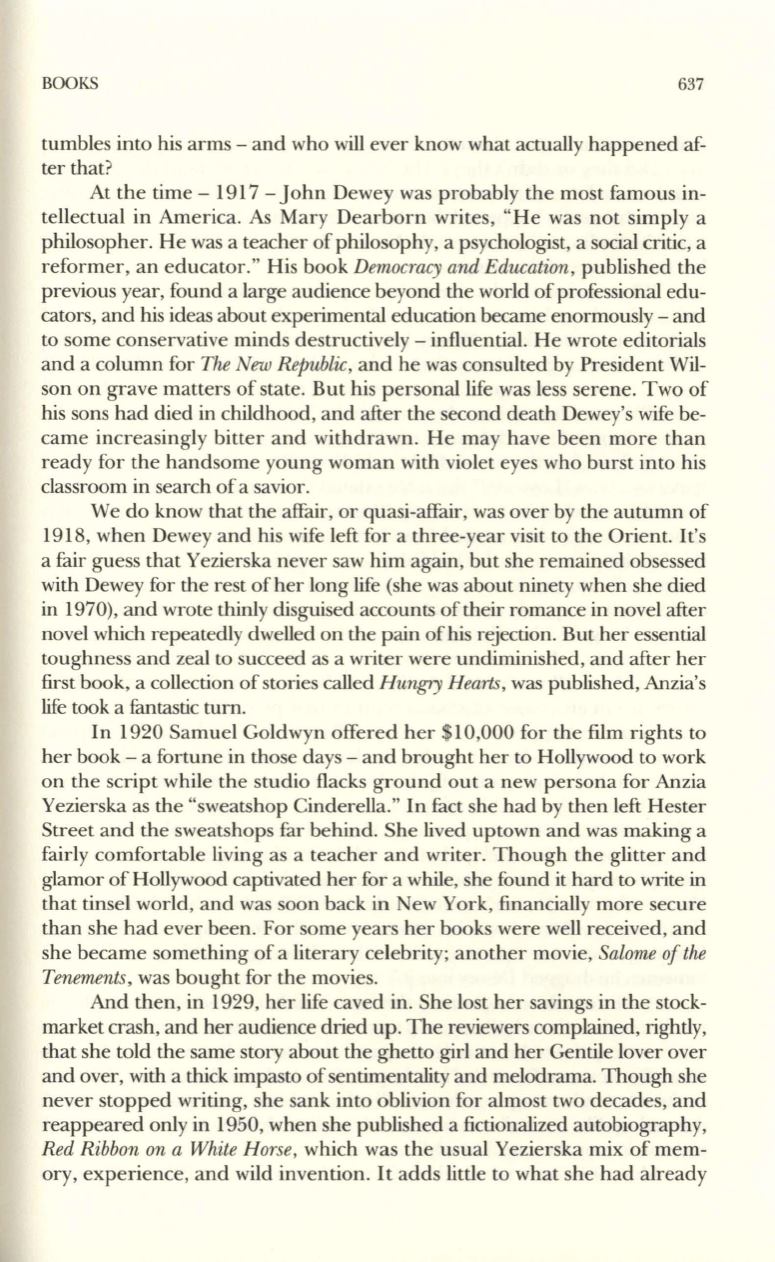
BOOKS
637
tumbles into his arms - and who will ever know what actually happened af–
ter that?
At the time - 1917 - John Dewey was probably the most famous in–
tellectual in America. As Mary Dearborn writes, "He was not simply a
philosopher. He was a teacher of philosophy, a psychologist, a social critic, a
reformer, an educator." His book
Democracy and Education,
published the
previous year, found a large audience beyond the world of professional edu–
cators, and his ideas about experimental education became enormously - and
to some conservative minds destructively - influential. He wrote editorials
and a column for
The New Republic,
and he was consulted by President Wil–
son on grave matters of state. But his personal life was less serene. Two of
his sons had died in childhood, and after the second death Dewey's wife be–
came increasingly bitter and withdrawn. He may have been more than
ready for the handsome young woman with violet eyes who burst into his
classroom in search of a savior.
We do know that the affair, or quasi-affair, was over by the autumn of
1918, when Dewey and his wife left for a three-year visit to the Orient. It's
a fair guess that Yezierska never saw him again, but she remained obsessed
with Dewey for the rest of her long life (she was about ninety when she died
in 1970), and wrote thinly disguised accounts of their romance in novel after
novel which repeatedly dwelled on the pain of his rejection. But her essential
toughness and zeal to succeed as a writer were undiminished, and after her
first book, a collection of stories called
Hungry Hearts,
was published, Anzia's
life took a fantastic turn.
In 1920 Samuel Goldwyn offered her $10,000 for the film rights to
her book - a fortune in those days - and brought her to Hollywood to work
on the script while the studio flacks ground out a new persona for Anzia
Yezierska as the "sweatshop Cinderella." In fact she had by then left Hester
Street and the sweatshops far behind. She lived uptown and was making a
fairly comfortable living as a teacher and writer. Though the glitter and
glamor of Hollywood captivated her for a while, she found it hard to write in
that tinsel world, and was soon back in New York, financially more secure
than she had ever been. For some years her books were well received, and
she became something ofa literary celebrity; another movie,
Salome olthe
Tenements,
was bought for the movies.
And then, in 1929, her life caved in. She lost her savings in the stock–
market crash, and her audience dried up. The reviewers complained, rightly,
that she told the same story about the ghetto girl and her Gentile lover over
and over, with a thick impasto of sentimentality and melodrama. Though she
never stopped writing, she sank into oblivion for almost two decades, and
reappeared only in 1950, when she published a fictionalized autobiography,
Red Ribbon on a White Horse,
which was the usual Yezierska mix of mem–
ory, experience, and wild invention. It adds little to what she had already


